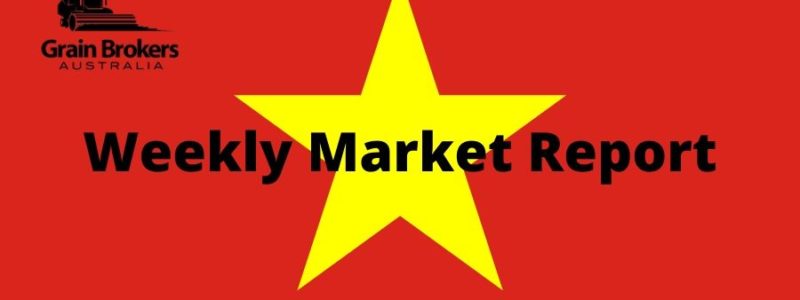The United States Department of Agriculture (USDA) released their November World Agricultural Supply and Demand Estimates (WASDE) to the market last Friday (Saturday morning down under) and there was nothing to get the trade, or futures markets, too excited.
Chicago Board of Trade (CBOT) December wheat futures closed the week at 510¼ cents per bushel (c/bu), down 2¼ c/bu on the day and down 5¾ c/bu for the week. Wheat futures have been trending downward since a 3-month high of 532¼ c/bu was set on October 18. That equates to a fall of almost AU$12 over the last three weeks.
The December corn futures contract closed last Friday’s trade at 377¼ c/bu, up 2 c/bu on the day but down 12 c/bu for the week. The soybean contract for November closed at 919½ c/bu, down 5½ c/bu on the day and down 4¾ c/bu for the week. Like wheat, both corn and soybean futures have been trending lower in recent weeks and have lost the equivalent of just under AU$12 and just over AU$11 respectively since the highs of mid-October.
The WASDE wheat production numbers were basically a juggling act, the result being a small global increase of around 0.3 million metric tonne (MMT). Australian production was decreased by 0.8MMT to 17.2MMt, similar to last year’s final number. However, this is still around 1.5MMT above many domestic trade estimates, and a further reduction is expected in the next report, due for release on December 10.
Argentine wheat production was decreased by 0.5MMT to 20MMT. Like Australia, this is around 1.5MMT above the most recent estimates emanating from the South American republic. Last season’s production was 19.5MMT. Reaping has commenced in many parts of the country, and the Buenos Aires Grain Exchange called the wheat harvest 7 per cent done compared to 11 per cent at the same time last year.
The United States (US) was the other major wheat producer which saw production fall compared to last month. The USDA pegged 2019/20 production at 52.3MMT, a decrease of 1.1MMT, but still, 1MMT higher than last season.
Planting of the next US winter wheat crop is well underway with 94 per cent expected to be planted by early this week. This compares to 89 per cent last week, 85 per cent last year and 92 per cent on average. Crop ratings are expected to be unchanged week-on-week at 57 per cent good to excellent, versus 51 per cent last year.
On the positive side of the equation, Ukraine, Russia and the European Union (EU) all saw increases to their final wheat numbers for the 2019/20 season compared to the October report. Ukraine production was increased by 0.3MMT to 29MMT. This represents a significant year-on-year increase of 4MMT, or 16 per cent.
The USDA increased Russian production by 1.5MMT to 74MMT. Here again, the USDA appears to be conservative with their revised estimate as local Russian forecasts are around 1-2MMT higher. That said, it is still around 2.3MMT higher than 2018/19 production.
The most significant increase to global wheat numbers in Friday’s WASDE report came in the EU. Production was posted at 153MMT, an increase of 1MMT compared to October and an increase of 16MMT compared to last season. However, the USDA number is 3MMT lower than the most recent European Commission wheat forecast of 156MMT.
In France, the European Union’s biggest wheat producer, planting of the winter wheat crop is delayed by wet weather. The French state grains board, FranceAgrimer, estimates that 67 per cent of the soft wheat crop has been planted, up 13 per cent on the previous week, but still well behind the long term average of 82 per cent.
With global wheat demand remaining static, the washup of all of the production changes was an increase in world ending stocks to a record 288.3MMT, 142.6MMT (49 per cent) of which is held outside of China.
On the barley front, the WASDE report was slightly bullish. The USDA cut Australian production by 0.2MMT to 8.4MMT. While this may be achievable, it appears to be on the high side based on the hard finish experienced in almost all the major barley production regions of the country.
Elsewhere, Argentine production was decreased by 0.1MMT to 4.7MMT (5.1MMT last year), the EU was raised by 0.2MMT to 61.8MMT (55.9MMT last year), and Ukraine was increased by 0.3MMT to 9.5MMT (7.6MMT last year).
The USDA increased global barley demand by 0.8MMT, predominantly in Russia, Ukraine and EU and world ending stocks were decreased by 0.8MMT, mostly in Russia and Saudi Arabia. Australian barley exports were reduced by 0.2MMT to 4.3MMT, and China’s barley imports were cut by 0.2MMT to 6.3MMt (5.5MMT last year).
There were several decreases to global corn supply, but most had already been factored into trade calculations, hence the subdued futures market reaction. US production was down by 3MMT after the yield forecast was decreased to 167 bushels per acre (10.5 metric tonne per hectare). Mexican, Ukraine and EU production were cut by 2MMT, 0.5MMT and 0.2MMT respectively, and Russian was increased by 0.5MMT.
US corn demand was down by 1.2MMT, but world demand was increased by 0.8MMT compared to the last WASDE report. World ending stocks are forecast to decrease by 6.6MMT, predominantly in Brazil, China, EU and the US.
The soybean numbers were quite benign, with global production down by 2.4MMT, mainly in India and Canada, and global demand down by 2.4MMT, primarily in India, China and the United States.
The grain market needs news, and the WASDE report provided nothing that wasn’t already known and factored into global thinking. From a wheat and barley perspective, 2019/20 production is basically known, even though the USDA numbers still need a little tweaking in several key jurisdictions.
A resolution, or otherwise, to trade disputes involving China is a key driver in the near term. The big one, of course, is the US standoff, with Trump seemingly dousing the most recent positive news with his usual Twitter diplomacy.
Call your local Grain Brokers Australia representative on 1300 946 544 to discuss your grain marketing needs.
















